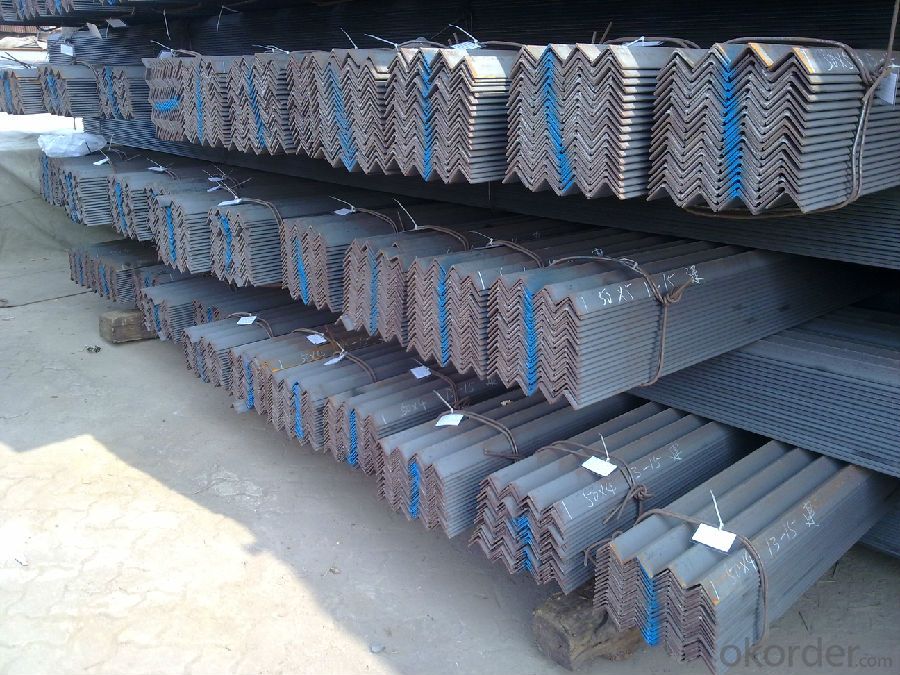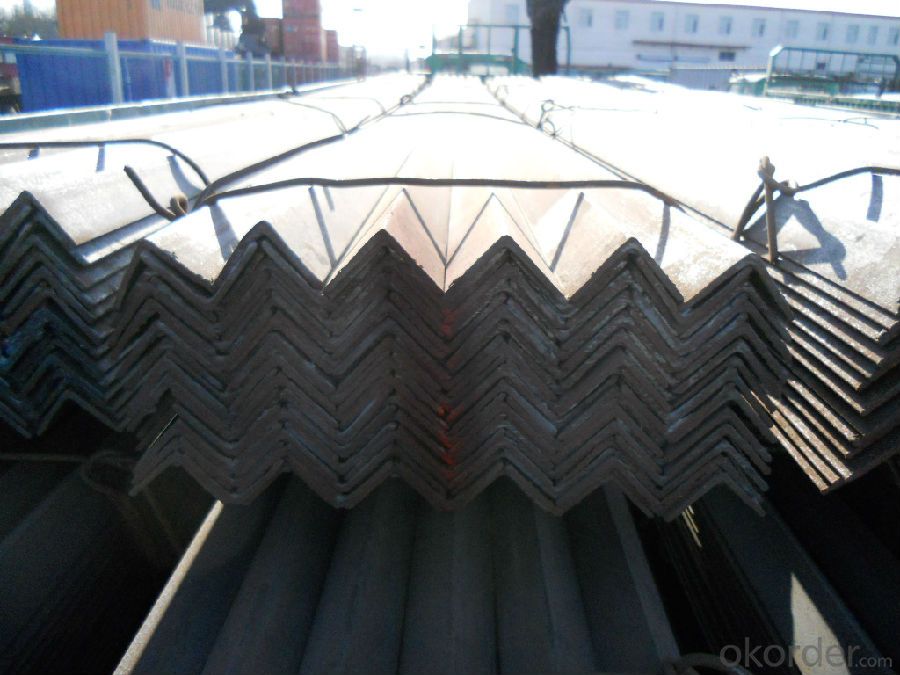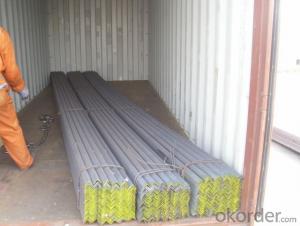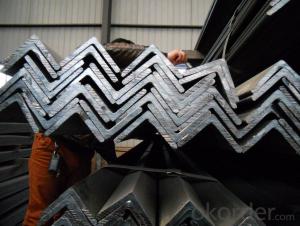Stainless GB,ASTM,BS,AISI,DIN,JIS Angle Steel
- Loading Port:
- Tianjin
- Payment Terms:
- TT OR LC
- Min Order Qty:
- 50 m.t.
- Supply Capability:
- 5000 m.t./month
OKorder Service Pledge
OKorder Financial Service
You Might Also Like
1. Structure of Angle Steel Description
Angle steel has equal angle, unequal angle.
Standards: GB,ASTM,BS,AISI,DIN,JIS
Invoicing on theoretical weight or actual weight as customer request
Material:Material: GB Q235B, Q345B or Equivalent; ASTM A36; EN 10025, S235JR, S355JR; JIS G3192, SS400; SS540.
2.Usage & Applications Stainless GB,ASTM,BS,AISI,DIN,JIS Angle Steel
Trusses;
Transmission towers;
Telecommunication towers;
Bracing for general structures;
Stiffeners in structural use.
3.Packaging & Delivery of Stainless GB,ASTM,BS,AISI,DIN,JIS Angle Steel
1. Transportation: the goods are delivered by truck from mill to loading port, the maximum quantity can be loaded is around 40MTs by each truck. If the order quantity cannot reach the full truck loaded, the transportation cost per ton will be little higher than full load.
2. With bundles and load in 20 feet/40 feet container, or by bulk cargo, also we could do as customer's request.
3. Marks:
Color mark: There will be color marking on both end of the bundle for the cargo delivered by bulk vessel. That makes it easily to distinguish at the destination port.
Tag mark: There will be tag mark tied up on the bundles. The information usually including supplier logo and name, product name, made in China, shipping marks and other information request by the customer.
If loading by container the marking is not needed, but we will prepare it as customer request.
Production flow of JIS SS400 Angle Steel
Material prepare (billet) —heat up—rough rolling—precision rolling—cooling—packing—storage and transportation


4.FAQ
We have organized several common questions for our clients,may help you sincerely:
①How about your company?
A world class manufacturer & supplier of castings forging in carbon steel and alloy steel,is one of the large-scale professional investment casting production bases in China,consisting of both casting foundry forging and machining factory. Annually more than 8000 tons Precision casting and forging parts are exported to markets in Europe,America and Japan. OEM casting and forging service available according to customer’s requirements.
②How to guarantee the quality of the products?
We have established the international advanced quality management system,every link from raw material to final product we have strict quality test;We resolutely put an end to unqualified products flowing into the market. At the same time, we will provide necessary follow-up service assurance.
③How long can we receive the product after purchase?
- Q:Can steel angles be used for architectural purposes?
- Yes, steel angles can certainly be used for architectural purposes. Steel angles are versatile structural components that can be used in various architectural applications. They are often used to provide structural support and stability in building construction. Steel angles can be used as lintels or beams to support the weight of walls, roofs, or floors. They can also be used as columns or braces to reinforce the structural integrity of a building. Additionally, steel angles can be used as decorative elements in architectural designs, adding a modern and industrial aesthetic to the overall look of a structure. Their durability, strength, and malleability make steel angles a popular choice for architects and engineers when designing and constructing buildings.
- Q:Can steel angles be used for fencing?
- Indeed, steel angles possess the potential for fencing. The utilization of steel angles is prevalent in fencing applications owing to their robustness, endurance, and adaptability. They furnish a solid structure for the fence, guaranteeing steadiness and security. The installation of steel angles is a task easily accomplished, and their configuration permits an array of fence designs and heights. Moreover, they exhibit resistance to rust and corrosion, rendering them appropriate for outdoor utilization. In summary, steel angles emerge as a favored option for fencing endeavors due to their structural soundness and enduring effectiveness.
- Q:How do steel angles perform in high-humidity environments?
- Steel angles perform well in high-humidity environments due to their corrosion-resistant properties. The presence of moisture does not significantly affect their structural integrity, making them a reliable choice for such conditions.
- Q:How do steel angles compare to other structural shapes like beams and channels?
- Steel angles, beams, and channels are all structural shapes commonly used in construction and engineering projects. While each shape has its own unique characteristics and advantages, steel angles offer specific benefits that make them a popular choice. One key advantage of steel angles is their versatility. They can be used in a wide range of applications, including supporting heavy loads, bracing structures, and providing framework for various structures. Due to their L-shaped design, steel angles can easily be welded or bolted together to create larger structures or frameworks. Compared to steel beams, angles are typically more cost-effective. They require less material to manufacture, making them a more economical choice for projects with budget constraints. Additionally, steel angles are often lighter in weight compared to beams, which can be beneficial when considering transportation and installation costs. Steel channels, on the other hand, offer similar benefits to steel angles but have a different shape. Channels have a U-shaped design, which allows for increased stability and support. They are commonly used for applications where additional strength is required, such as in the construction of bridges, buildings, and machinery. While steel angles may not provide the same level of strength and load-bearing capacity as steel beams or channels, they are still a reliable choice for many structural applications. Their versatility, cost-effectiveness, and ease of installation make them a preferred option for a wide range of construction and engineering projects.
- Q:How do you calculate the load-bearing capacity of a steel angle?
- To calculate the load-bearing capacity of a steel angle, you need to consider factors such as the dimensions of the angle, the material properties of the steel, and the type of loading it will experience. The load-bearing capacity can be determined using engineering formulas or reference tables that take into account the angle's cross-sectional area, moment of inertia, and the yield strength of the steel. Additionally, structural design codes and standards should be consulted to ensure the calculated load-bearing capacity meets the required safety factors and regulations.
- Q:Are steel angles prone to rust or corrosion?
- Steel angles have a tendency to rust or corrode. When steel comes into contact with oxygen and moisture, it undergoes a chemical reaction known as oxidation, which leads to the creation of iron oxide, commonly referred to as rust. This reaction can gradually weaken the structural strength of the steel angles. To prevent or reduce rust and corrosion, it is common practice to coat steel angles with protective layers such as paint, galvanization, or other anti-corrosion treatments. It is essential to regularly perform maintenance and inspections to promptly detect and address any indications of rust or corrosion in order to extend the lifespan and optimize the performance of steel angles.
- Q:Are steel angles resistant to pests and insects?
- Yes, steel angles are resistant to pests and insects as they are not a food source and provide no habitat for them.
- Q:Are steel angles affected by creep?
- Yes, steel angles are indeed affected by creep. Creep is a phenomenon where materials, including steel, deform over time under a constant load or stress. Steel angles, being structural components, are subjected to various loads and stresses, especially if they are part of long-term applications such as bridges or buildings. Over time, the sustained stress can cause the steel angles to gradually deform, leading to creep. Therefore, it is essential to consider creep effects when designing structures that incorporate steel angles to ensure long-term structural integrity.
- Q:What are the common sizes and dimensions of steel angles?
- The sizes and dimensions of steel angles differ based on the specific application and industry standards. There exist certain standard sizes commonly employed in construction and structural engineering. An equal angle, which consists of two sides of equal length and a 90-degree angle between them, stands as one of the most frequently used sizes of steel angles. These angles are typically available in sizes ranging from 20x20mm to 200x200mm, with thicknesses varying from 3mm to 20mm. Equal angles may vary in length from 6 meters to 12 meters, although shorter lengths could be accessible. Another type, the unequal angle, comprises two sides of different lengths and a 90-degree angle between them. The sizes and dimensions of unequal angles can significantly vary, depending on project requirements. However, some common sizes for unequal angles range from 40x25mm to 200x150mm, with thicknesses ranging from 3mm to 15mm. Like equal angles, the length of unequal angles can also differ but typically falls between 6 meters and 12 meters. It is important to recognize that these dimensions are not exhaustive, and additional sizes may be obtainable based on the manufacturer and project-specific needs. Moreover, steel angles can be custom fabricated to satisfy unique design requirements. Overall, steel angles serve as versatile structural components applicable in framing, support structures, and bracing, among other uses. The selection of size and dimensions relies on factors such as load capacity, structural requirements, and aesthetic preferences.
- Q:What is the weight-bearing capacity of steel angles?
- The weight-bearing capacity of steel angles is determined by a range of factors, including the angle's dimensions, thickness, the type of steel employed, and the specific load it bears. Due to their strength and load-bearing capabilities, steel angles find widespread use in construction and structural applications. Nevertheless, it is crucial to refer to engineering tables or seek guidance from a structural engineer to ascertain the precise weight-bearing capacity of a steel angle in a given scenario.
1. Manufacturer Overview |
|
|---|---|
| Location | |
| Year Established | |
| Annual Output Value | |
| Main Markets | |
| Company Certifications | |
2. Manufacturer Certificates |
|
|---|---|
| a) Certification Name | |
| Range | |
| Reference | |
| Validity Period | |
3. Manufacturer Capability |
|
|---|---|
| a)Trade Capacity | |
| Nearest Port | |
| Export Percentage | |
| No.of Employees in Trade Department | |
| Language Spoken: | |
| b)Factory Information | |
| Factory Size: | |
| No. of Production Lines | |
| Contract Manufacturing | |
| Product Price Range | |
Send your message to us
Stainless GB,ASTM,BS,AISI,DIN,JIS Angle Steel
- Loading Port:
- Tianjin
- Payment Terms:
- TT OR LC
- Min Order Qty:
- 50 m.t.
- Supply Capability:
- 5000 m.t./month
OKorder Service Pledge
OKorder Financial Service
Similar products
New products
Hot products
Related keywords




























